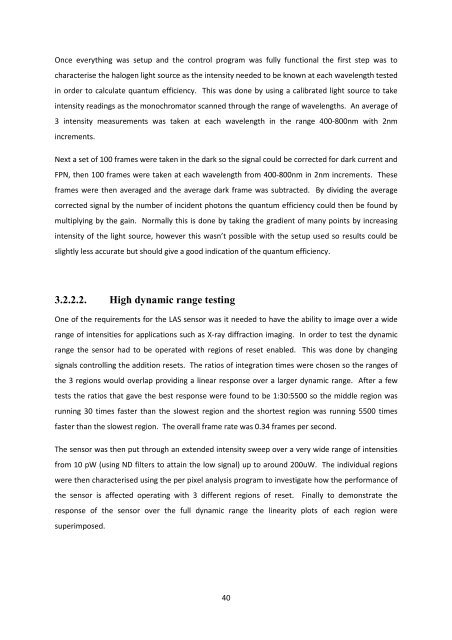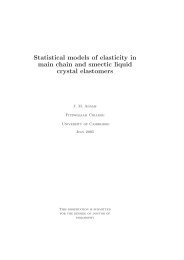Dissertation - FTP Directory Listing - University of Surrey
Dissertation - FTP Directory Listing - University of Surrey
Dissertation - FTP Directory Listing - University of Surrey
You also want an ePaper? Increase the reach of your titles
YUMPU automatically turns print PDFs into web optimized ePapers that Google loves.
Once everything was setup and the control program was fully functional the first step was tocharacterise the halogen light source as the intensity needed to be known at each wavelength testedin order to calculate quantum efficiency. This was done by using a calibrated light source to takeintensity readings as the monochromator scanned through the range <strong>of</strong> wavelengths. An average <strong>of</strong>3 intensity measurements was taken at each wavelength in the range 400-800nm with 2nmincrements.Next a set <strong>of</strong> 100 frames were taken in the dark so the signal could be corrected for dark current andFPN, then 100 frames were taken at each wavelength from 400-800nm in 2nm increments. Theseframes were then averaged and the average dark frame was subtracted. By dividing the averagecorrected signal by the number <strong>of</strong> incident photons the quantum efficiency could then be found bymultiplying by the gain. Normally this is done by taking the gradient <strong>of</strong> many points by increasingintensity <strong>of</strong> the light source, however this wasn’t possible with the setup used so results could beslightly less accurate but should give a good indication <strong>of</strong> the quantum efficiency.3.2.2.2. High dynamic range testingOne <strong>of</strong> the requirements for the LAS sensor was it needed to have the ability to image over a widerange <strong>of</strong> intensities for applications such as X-ray diffraction imaging. In order to test the dynamicrange the sensor had to be operated with regions <strong>of</strong> reset enabled. This was done by changingsignals controlling the addition resets. The ratios <strong>of</strong> integration times were chosen so the ranges <strong>of</strong>the 3 regions would overlap providing a linear response over a larger dynamic range. After a fewtests the ratios that gave the best response were found to be 1:30:5500 so the middle region wasrunning 30 times faster than the slowest region and the shortest region was running 5500 timesfaster than the slowest region. The overall frame rate was 0.34 frames per second.The sensor was then put through an extended intensity sweep over a very wide range <strong>of</strong> intensitiesfrom 10 pW (using ND filters to attain the low signal) up to around 200uW. The individual regionswere then characterised using the per pixel analysis program to investigate how the performance <strong>of</strong>the sensor is affected operating with 3 different regions <strong>of</strong> reset. Finally to demonstrate theresponse <strong>of</strong> the sensor over the full dynamic range the linearity plots <strong>of</strong> each region weresuperimposed.40
















